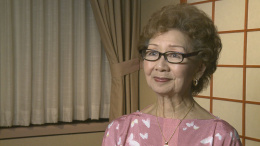Mary Nomura
| Name | Mary Nomura |
|---|---|
| Born | September 29 1925 |
| Birth Location | Los Angeles |
| Generational Identifier |
Singer known as the "Songbird of Manzanar." Born and raised in Los Angeles as Mary Kageyama, she was the fourth of five children born to Japanese immigrants Tomitaro and Machi Kageyama, a carpenter and a teacher of Japanese dance, respectively. Her father died when when she was three, and after remarrying, her mother died in childbirth when Mary was eight. Her eldest brother and sister both quit school and worked to support the family. Despite the tragedies, Mary was able to take signing and dancing lessons and performed as a singer in both Japanese and western styles as a child. She also formed a singing trio with a brother and sister.
A sixteen-year-old student at Venice High School when the war broke out, she and her family went directly to Manzanar in April 1942. She continued her high school education in camp, while also working as a receptionist and file clerk. She also was a member of a Nisei girls club, the Modernaires. She was also able to continue taking music lessons, with a young music teacher, Lou Frizzell, becoming her mentor. Often with his accompaniment, she would sing at various programs at the high school and throughout the camp, including talent shows and dances. Through her performances, she gained the nickname the "Songbird of Manzanar." Frizzell also arranged for her to record two songs while at Manzanar.
While in camp, she met her future husband, Shi Nomura, whose family farmed southeast of Los Angeles. She left camp in January of 1945, the whole family leaving when her brother got a job offer from Cal Tech and settling in Pasadena, California. Shi left two months later and the couple got married in June of 1945. After working as a gardener and various other jobs, he eventually started a successful grocery story, which he ran for twenty-five years.
After the war, Nomura bore and raised five children and was mostly a stay-at-home wife and mother in Garden Grove, California. She never pursued a professional singing career. However, she sang when asked at community events. With the growing awareness and interest in the history of the incarceration among Japanese Americans starting in the 1970s and 1980s, Nomura's performances grew more frequent, at events such as the annual Manzanar Pilgrimage . She also performed in the camp-themed revue, The Camp Dance: The Music & The Memories , starting in 2003. She has been featured in three documentaries, Words, Weavings & Songs produced by the Japanese American National Museum in 2002, a 2005 episode of California's Gold with Huell Howser , and a 2016 short film by Cody Edison titled Songbird of Manzanar .
For More Information
California's Gold with Huell Howser: Songbird of Manzanar . Written and produced by Huell Howser. 25 minutes. Huell Howser Productions, 2005.
Mary Nomura interview by John Allen. Manzanar National Historic Site Collection, Densho Digital Repository, Nov. 7, 2002.
Mary Kageyama Nomura interview by Tom Ikeda, Densho Digital Repository, July 9, 2009.
Songbird of Manzanar . Directed by Cody Edison. 16 minutes. 2016.
Stanley, Jerry. I Am an American: A True Story of Japanese Internment . New York: Crown Publishers, 1994. [Juvenile book on the incarceration told through Shi Nomura's story includes a chapter on Mary.]
Words, Weavings & Songs . Produced and directed by John Esaki. 34 minutes. Japanese American National Museum, 2002.
Last updated Feb. 20, 2024, 5:54 a.m..

 Media
Media

